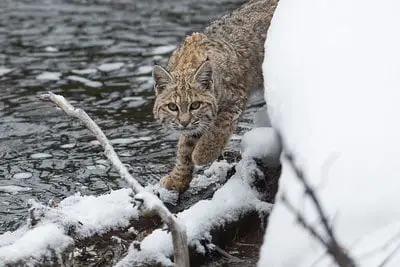Want to know the laws for hunting bobcats in Vermont? This article covers many of the fundamental laws you will need to know to get started. It also provides information such as seasons, harvest limits, and required permits for bobcat hunting in Vermont. It is not a legal document and is not intended to cover all hunting laws and regulations.

In Vermont, the bobcat hunting season runs from Jan. 10 – to Feb. 7. A license is required, and the hunting hours are one-half hour before sunrise to one-half hour after sunset—no bag limits.
Purchase a Vermont hunting license here.
Check out all the Vermont hunting seasons.
If this is your first time hunting bobcats, please give these two articles a read.
How to read and age bobcat sign.
Three vital tips for a successful bobcat hunt.
Related: You can also hunt coyotes in this state. Learn the rules for hunting coyotes in Vermont.
Related: Learn the rules for hunting fox in Vermont.
General laws for hunting bobcats in Vermont.
Suppressors. While owning a suppressor is legal, at this time in 2022, it is not lawful to hunt with one.
Electronic callers and decoys. Appear to be legal at this time. Please check for updates and changes.
While electronic callers are expensive, mouth and hand callers are cheaper but harder to use.
Read this article and watch the video to learn how to use a closed reed rabbit squealer.
Follow along as call manufacturer Brian Rush shows you three open reed calls you can learn and use today.
You can check the price for an electronic caller on Amazon.
Related: You can read about some highly effective but inexpensive ($20) coyotes decoys here.
Tags required when hunting bobcats in Vermont.
- The skins of bobcat, otter and fisher legally taken may be possessed, transported, bought and sold only when tagged and marked as hereinafter provided.
- A person who takes bobcats, otter or fisher during these seasons shall notify authorized department staff within 48 hours of the close of the season. Pelts shall be presented to authorized department staff for tagging. Such tags shall remain affixed to the pelts until tanned. Carcasses shall be surrendered to authorized department staff at the time of tagging.
- No bobcat, otter or fisher pelts or carcasses taken during these seasons shall be transported out of the state of Vermont prior to being tagged by authorized department staff.
- A person who takes bobcat, fisher and otter pursuant to 10 V.S.A. § 4828 and who desires to keep the pelt shall notify authorized department staff within 84 hours of the taking. Pelts shall be presented to authorized department staff for tagging. Such tags shall remain affixed to the pelts until tanned. Carcasses shall be surrendered to authorized department staff at the time of tagging.
Road and aerial hunting bobcats in Vermont.
Road Hunting
A person shall not take or attempt to take any wild animal by shooting a firearm, muzzleloader, bow and arrow, or crossbow while on the traveled portion of any public highway (class 1, 2, 3, or 4), nor within 25 feet of a class 1, 2, or 3 public highway as designated on a town highway map. It is illegal to shoot a firearm, muzzleloader, bow and arrow, or crossbow over or across the travelled portion of a public highway. Violators are subject to a fine of up to $1,000.
Aerial Hunting
It is unlawful for any person to take or attempt to take wild animals while a person is in an aircraft. Aircraft includes, but is not limited to, planes and helicopters.
It shall be unlawful for any person to take or attempt to take wild animals by use of an unmanned aerial vehicle or drone. “Drone” means any device capable of flying in the air which is remotely, automatically or otherwise piloted without an occupant.
It is unlawful for any person to use an aerial vehicle, drone or unmanned aircraft to:
- Attempt to locate, surveil, or aid or assist in attempting to locate or surveil any wild animal for the purpose of taking or attempting to take a wild animal; or
- Communicate the location of any wild animal to any person on the ground for the purpose of taking or attempting to take a wild animal; or
- Drive, harass, or otherwise assist or aid in the taking or attempting to take a wild animal.

